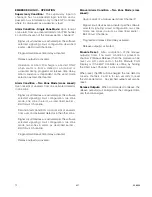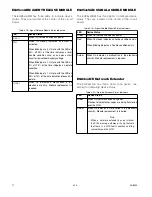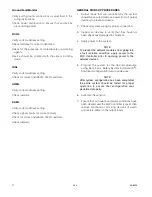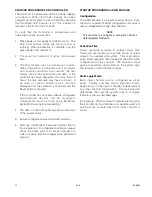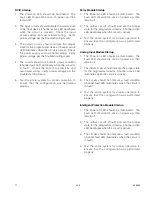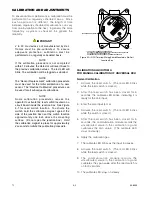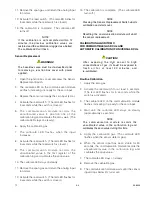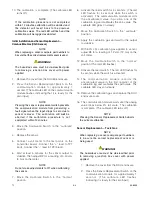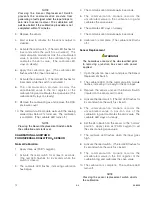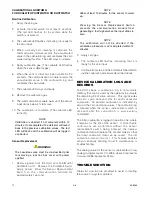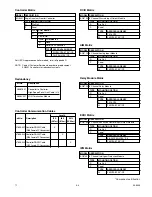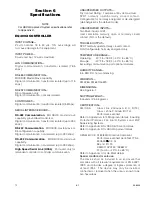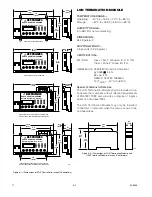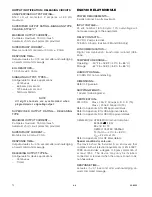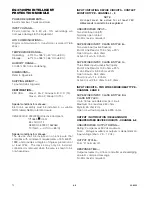
7.1
95-8533
5-4
10. The calibration is complete. (The calibrate LED
turns off.)
NOTE
If the calibration procedure is not completed
within 12 minutes, calibration will be aborted and
the detector will revert back to the previous
calibration values. The red LED will flash and the
calibration will be logged as aborted.
Initial Installation and Sensor Replacement —
Combustible Gas (CGS Sensor)
NOTE
When replacing a sensor, compare part numbers to
be sure that the correct replacement sensor is used.
wARNING!
The hazardous area must be de-classified prior
to removing a junction box cover with power
applied.
1. Remove the cover from the DCUEX enclosure.
2. Press the Sensor Replacement Switch on the
communication module for approxImately 1
second. (The calibrate LED on the communication
module flashes, indicating that it is ready for the
zero input.)
NOTE
Pressing the sensor replacement switch prevents
the communication module from generating a
fault signal when the input drops to zero due to
sensor removal. The calibration will
not
be
aborted if the calibration procedure is not
completed within 12 minutes.
3. Move the Calibration Switch to the “calibrate”
position.
4. Replace the sensor.
5. Connect a volt meter to the test points on the
transmitter board. Connect the “+” lead to TP1
(red). Connect the “–” lead to TP2 (black).
6. Wait at least 5 minutes for the sensor output to
stabilize, then adjust R2 for a reading of 0.40 vdc
(4 ma) on the meter.
NOTE
Do not make adjustments to R1 when calibrating
the sensor.
7. Move the Calibrate Switch to the “normal”
position.
8. Activate the reed switch for 4 seconds. (The red
LED flashes for 3 seconds while the switch is
activated.) The communication module records
the uncalibrated value in position one of the
calibration log and calibrates the zero value. The
calibrate LED goes on steady.
9. Move the Calibration Switch to the “calibrate”
position.
10. Apply the calibration gas and wait for the output
to stabilize.
11. With 50% LFL calibration gas applied to sensor,
adjust R3 for a reading of 1.2 vdc (12 ma) on the
volt meter.
12. Move the Calibrate Switch to the “normal”
position. (The red LED flashes.)
13. Activate the reed switch. The red LED flashes for
3 seconds while the switch is activated.
14. The communication module records the
uncalibrated value in the first register of the
calibration log and calibrates the span value. The
calibrate LED stays on steady.
15. Remove the calibration gas and replace the DCU
enclosure cover.
16. The communication module waits until the analog
value drops below 4% full scale. The calibration
is complete. (The calibrate LED turns off.)
NOTE
Pressing the Sensor Replacement Switch aborts
the current calibration.
Sensor Replacement — Toxic Gas
NOTE
When replacing a sensor, compare part numbers
to be sure the correct replacement sensor is
being used.
wARNING!
The hazardous area must be de-classified prior
to removing a junction box cover with power
applied.
1. Remove the cover from the DCU enclosure.
2. Press the Sensor Replacement Switch on the
communication module for approximately 1
second. (The calibrate LED flashes,
indicating it is ready for the zero input.)
Содержание DET-TRONICS 95-8533
Страница 1: ...Instructions 95 8533 Eagle Quantum Premier Fire and Gas Detection Releasing System 7 1 9 09 95 8533 ...
Страница 128: ...7 1 95 8533 A 4 Figure A 1 System Drawing 007545 001 ...
Страница 129: ...95 8533 A 5 7 1 Figure A 2 System Drawing 007545 001 ...
Страница 131: ...95 8533 7 1 B 2 Figure B 1 Drawing 007546 001 ...
Страница 132: ...95 8533 7 1 B 3 Figure B 2 Drawing 007546 001 ...
Страница 134: ...95 8533 7 1 C 2 Figure C 1 Drawing 007547 001 ...
Страница 141: ...95 8533 7 1 D 7 Figure D1 System Drawing 007545 001 ...
Страница 143: ...APPENDIX E E 1 95 8533 7 1 ...



